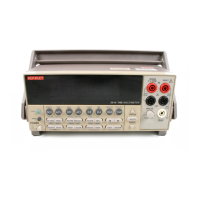Calibration Reference B-21
Detecting calibration step completion
When sending remote calibration commands, you must wait until the instrument completes
the current operation before sending a command. You can use either *OPC? or *OPC to help
determine when each calibration step is completed.
Using the *OPC? query
With the *OPC? (operation complete) query, the instrument will place an ASCII 1 in the out-
put queue when it has completed each step. To determine when the OPC response is ready, do
the following:
1. Repeatedly test the MAV (Message Available) bit (bit 4) in the status byte and, wait until
it is set. (You can request the status byte by using the *STB? query or by serial polling.)
2. When MAV is set, a message is available in the output queue, and you can read the output
queue and test for an ASCII 1.
3. After reading the output queue, repeatedly test MAV again until it clears. At this point,
the calibration step is completed.
Using the *OPC command
The *OPC (operation complete) command can also be used to detect the completion of each
calibration step. To use *OPC to detect the end of each calibration step, you must do the
following:
1. Enable operation complete by sending *ESE 1. This command sets the OPC (oper-
ation complete bit) in the standard event enable register, allowing operation com-
plete status from the standard event status register to set the ESB (event summary
bit) in the status byte when operation complete is detected.
2. Send the *OPC command immediately following each calibration command. For
example:
:CAL:PROT:DC:STEP1;*OPC
Note that you must include the semicolon (;) to separate the two commands and that the
*OPC command must appear on the same line as the calibration command.
3. After sending a calibration command, repeatedly test the ESB (Event Summary) bit (bit
5) in the status byte until it is set. (Use either the *STB? query or serial polling to request
the status byte.)
4. Once operation complete has been detected, clear OPC status using one of two methods:
(1) Use the *ESR? query, then read the response to clear the standard event status regis-
ter, or (2) send the *CLS command to clear the status registers. Note that sending *CLS
will also clear the error queue and operation complete status.

